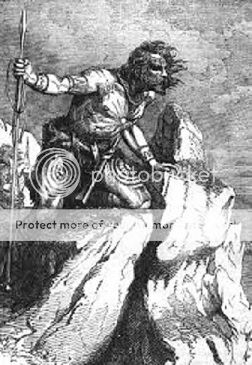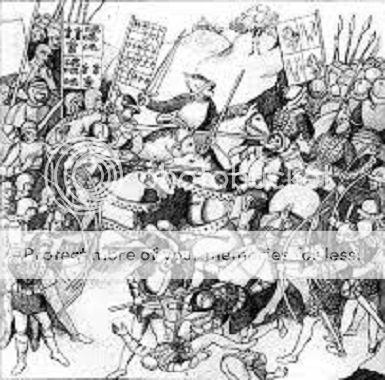Freedom is a noble thing - A Scottish Megacampaign, Part Two
- Thread starter Tommy4ever
- Start date
-
We have updated our Community Code of Conduct. Please read through the new rules for the forum that are an integral part of Paradox Interactive’s User Agreement.
You are using an out of date browser. It may not display this or other websites correctly.
You should upgrade or use an alternative browser.
You should upgrade or use an alternative browser.
[URL="http://forum.paradoxplaza.com/forum/showthread.php?776334-Freedom-is-a-noble-thing-A-Scottish-Megacampaign-Part-One"] [/URL]
[/URL]

 [/URL]
[/URL]
Hello all! Its taken slightly longer than I'd hope to start Part Two of this Megacampaign (Part One can be accessed through the picture above), but its finally arrived! I will start out this portion of the AAR with two summary updates - the first looking a brief summary of Scottish history up until 1425 (when the CKII part of the AAR ended) and the second an overview of the entire world.
Hope to see the readers of the first AAR carry on here, and some new faces turn up too.
Last edited:
I have caught up from part 1 and am now subbed! Hope this will be as good as the Egypto-Norse mega-campaign.
Scotland in the Middle Ages
Born in Flames
793-903
Prior to the 9th century, the area we know as ‘Scotland’ today was ruled over by a patchwork of petty Kingdoms and warlords from a diverse array of cultures – Pictish, Anglo-Saxon, Byrthronic, Gaelic-Scots and others. The balance of power amongst these small realms was drastically altered by the dawn of the Viking era as Norse raiders threatened to reduce the British Isles to ruins. In the far North of the Isle of Britain, during the 840s, the warlord Kenneth MacAlpin unified the Kingdoms of the Picts and the Gaelic speaking Scots – a moment commonly regarded as the founding of the Kingdom of Scotland – and subsequently brought a degree of stability to the region by resisting Norse attack.
Through the rest of the 9th century, Kenneth and his successors vied continued to battle against their external Norse enemies, frequently cooperating with the Anglo-Saxon Kingdoms to the South towards the end of the period, whilst striving to stabilise and solidify the MacAlpin dynasty’s domination of Scotland. Their main internal rivals were the upstart MacDrostans – who emerged from humble origins in Fife in the middle of the century to amass a vast powerbase around the Firths of Forth and Tay. Despite the rise of the MacDrostans, at the end of the 800s, the MacAlpin monarchy was more powerful than it had ever been before.
The Golden Age
903-1098
The fall of a Kingdom to foreign, barbarian, invaders seems a strange moment to date the beginning of a Golden Age. Yet, the glories of the 10th and 11th centuries were triumphs of the MacDrostans as much as they were of Scotland, and the collapse of the MacAlpin Kingdom at the beginning of the 10th century was unquestionably a great moment for the dynasty. Having faced the consequences of a failed rebellion in the 890s, Donald the Wise MacDrostan was at a low ebb with the Norwegians landed in Scotland, soon finding himself allied to the invaders he went on to become a key component of the Norwegian Empire – enforcing the King of Norway’s rule in Scotland in the years after the invasion. However, as soon the power of the Norwegians started to wane, Donald abandoned his allegiances – leading a rebellion against their rule in 914 and then proclaiming himself King of Scotland in 916 before eventually pushing them from Scottish territory for good in the latter years of his life.
Donald II of Scotland, the first of the MacDrostan Kings, ushered in a pattern of constant territorial expansion, of the outward projection of Scottish power, of relative social harmony and of economic prosperity that would last until the end of 11th century and transform Scotland into one of Europe’s leading powers. During this period the ‘Scots’ culture began to emerge – spreading far to the South along with the Kingdom’s borders. At the end of the Golden Age, although they were not set in stone, the customary borders of Kingdom of Scotland roughly along the Humber and Severn Rivers had been established.
Throughout the Golden Age Scotland became home to some incredible personalities, who’s feats have endured in the popular consciousness for a millennium, including Brice the Bold, who lived to the age of 84 and ruled Scotland for an incredible 78 years, Murdoch II, who defeated the mighty Caliph and established the first Kingdom of Jerusalem, and perhaps most reverberatingly, Annabella the Maid – a humble peasant girl who sparked off a folk religious movement that left an imprint on Scottish society for centuries and displayed spectacular military genius whilst still in her youth.
The Feudal Crisis Begins
1098-1263
From the beginning of the 11th century, Scotland’s Golden Age came to a shuddering halt – from the First Fraticelli Wars that afflicted Murdoch III, the Kingdom went through an endless succession of debilitating civil wars which set the nobility against the monarchy, the peasantry against the nobility, the town against the country and Catholics against Heretics.
The period of crisis began with Murdoch III’s decision to embrace the Fraticelli faith – a religious movement that had emerged from the collision of theological ideas emanating from Italy and Scotland’s native tradition of popular, egalitarian, folk religion that became a feature of the Kingdom from the lifetime of Annabella the Maid onwards. The First Fraticelli Wars, which eventually resulted in Murdoch’s overthrow by his own son, opened up a rupture in Scottish society which proved impossible to heal, whilst at the same time successive monarchs exasperated the situation by persistently pushing for the centralisation of power around the Scots crown. It was during this period that the House MacGiric emerged as a genuine rival to the MacDrostans – expanding its power across the country and making numerous attempts to establish one of its own on the Scottish throne.
Notably, after a century in which the Scots had been relatively docile in foreign affairs, Thomas III launched a grand expedition into the Baltic at the beginning of the 13th century – seeking to bring down the Cathar rulers of Poland and the Pagans of Lithuania. In the end he successfully forced the King of Lithuania to become a Christian, and made himself King of Poland – marking the beginning of Scotland’s attachment to the region. Although Scottish rule in Poland was interrupted between 1235 and 1244 by the Mongol Invasions, the two countries would become inextricably linked during the Latter Middle Ages.
The Second Fraticelli Wars
1263-1335
The Second Fraticelli Wars marked the violent dénouement of Scotland’s feudal crisis. The bitter struggle for Scotland’s soul totally transformed the Kingdom. By the end of the conflicts, Scotland was ruled by an all-powerful proto-absolutist monarchy, enjoyed a degree of religious toleration that was unthinkable across most of Europe and stood at the head of the Christian world’s largest and most powerful Empire.
The Second Fraticelli Wars emerged from the reign of Robert I (reigned 1263-1322), arguably the most remarkable individual of the Middle Ages to whom it is impossible to do justice in a few brief words. He was a man who was blessed with truly incredible abilities, but was cursed with crippling mental illness that led to him hearing the voices of both Christ and the Devil, shifting rapidly and without warning from incredible cruelty to touching kindness, from utter madness to period of spectacular brilliance. Robert, unlike his conservative predecessors, aligned himself with the radical elements in Scottish society, and the Fraticelli. Inevitable the Kingdom descended into total anarchy, with the Civil Wars continuing for years after his death – the arch traditionalist Murdoch IV, who married the Holy Roman Empress in 1314, and his successors clashing with his Fraticelli half-brothers for the control over the Kingdom’s future. In the end, the traditionalist were triumphant and a brutal reaction against the Fraticelli began in earnest whilst Scotland’s Kings left the historic capital of Stirling (the seat of Scottish Kings since 916) for Breda, where they enjoyed the largess of their new position as Holy Roman Emperors.
The MacDrostan Empire
1335-1425
In 1335 Morgan I, Longshanks, became King of Scotland and Holy Roman Emperor. In both Scotland, and after a Civil War in Germany as well, he established a stable settlement that appeared to secure an Empire that stretched across Scotland, Poland, Germany, Iceland, Skane, parts of the Low Countries and latterly Lithuania as well. A descendant of the Fraticelli wing of the MacDrostan dynasty, but a devout Catholic, Morgan established peace in Scotland – offering a degree of religious toleration (so long as the Fraticelli once again remained within the One True Church), and demanding total obedience from the nobility in exchange for privileges within his wider Empire. In Germany, the nobility was denied power at the Imperial court, with Scots favoured, but given a substantial degree of autonomy.
Morgan’s delicately balanced system did not survive his death in 1366 as the MacDrostan Empire started to unravel. Under his successor, Patrick the German, the Baltic realms were lost almost immediately as they were let free so that the Scottish and German core of the Empire could be preserved. However, through his reign, Patrick undermined Morgan’s Imperial system as he attempted to enhance his power within Germany whilst at the same time showing a disinterest in maintaining the Imperial privileges of the Scots nobility. When Morgan II, a sympathist with the Fraticelli elements within the Scottish Church, arose to become King-Emperor in 1411 the MacDrostan Empire entered into its final collapse. In Scotland, Gilbert MacGiric, later remembered as ‘the Liberator’, organised a Parliament in Edinburgh – calling upon the Scots nobility, clergy and burghers to rally behind a rebellion - as the world renowned Magna Carta was issued. Within two years MacDrostan rule in Scotland was over, Gilbert becoming the first King of the MacGiric dynasty in 1413. On the continent, Morgan clung to power – eventually retaining the throne on the condition that the Imperial succession laws pass from ones based upon Primogeniture, and the preservation of MacDrostan rule, to elective laws that favoured the native German Princes.
In Scotland, Gilbert MacGiric obliterated the proto-absolutist regime of 14th century, replacing it with one based upon a balance between the King and a powerful Parliament backed by a strong and self-confident nobility. For a little over a decade, Gilbert’s new Scotland appeared to be entering into a new Golden Age as peace, stability and prosperity reigned in Scotland once more. In the 1420s all this began to change dramatically as the Black Death began tore through Scottish society – claiming the life of its King in 1425.







